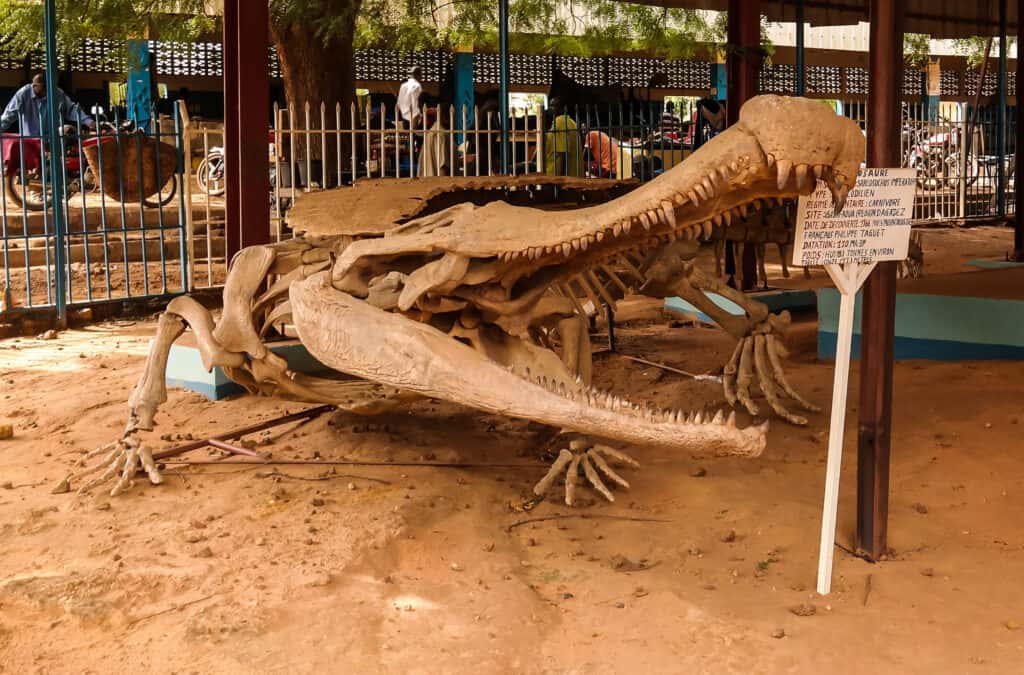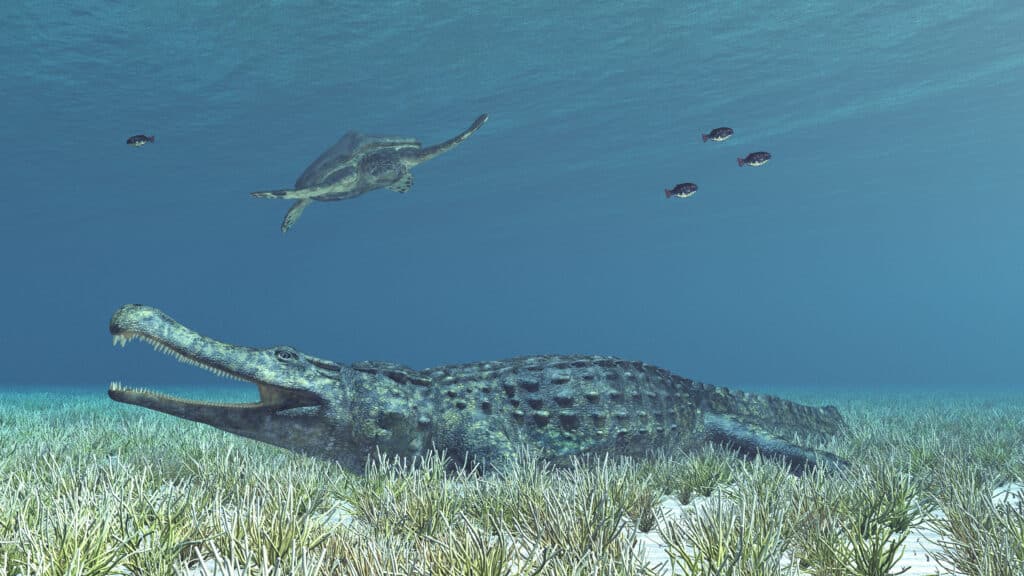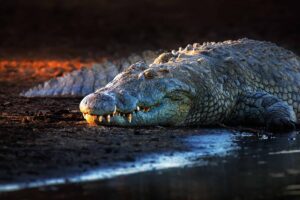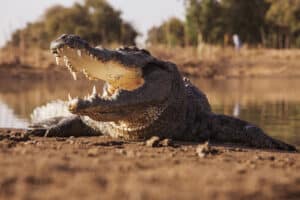Crocodiles are one of the largest reptiles in the world, capable of reaching about 17 feet in length, which is more than twice the average human’s height. These cold-blooded predators are also known for their incredible biting force and strong tails. They can bring down large animals such as deer, snakes, and other crocodiles, crushing bones and hard shells with their powerful jaws.
The saltwater crocodile is the largest crocodile species in the world and the largest living reptile. However, it is not the largest crocodile to ever roam the earth. The largest crocodile weighed up to 17,500 pounds, about eight times larger than the largest saltwater crocodile. “What did this crocodile eat to feed its massive body?” you may wonder. Find out below!
What Is The Largest Crocodile Ever?

Sarcosuchus imperator is the largest crocodile to have ever lived.
©HombreDHojalata / CC BY-SA 3.0 – License
The largest crocodile ever is Sarcosuchus imperator. This giant crocodile lived in the Mid-Cretaceous Period over 100 million years ago. During this period, gigantism was rampant among aquatic and land animals, with the most popular species being the dinosaurs.
Sarcosuchus imperator grew up to 40 feet long and weighed up to 17,500 pounds. These large reptiles took about 50 to 60 years to reach their maximum size, which is less time than it takes a modern crocodile.
Sarcosuchus Imperator Vs. Largest Living Crocodile In Captivity
The record for the largest living crocodile in captivity is held by an Australian saltwater crocodile named Cassius. According to the Guinness World Records, Cassius measures about 18 feet long and weighs more than 2,200 pounds. The croc was captured in 1984 by a man named George Craig in the Finis River, and in 1987 was transferred to Marineland Melanesia on Green Island in Australia.
Though Cassius is a scary-looking giant, he still falls far below Sarcosuchus imperator, which is about eight times its weight. The ancient crocodile also exceeded Cassius in length and bite force. The Australian saltwater croc is reported to prey on chicken, fish, and pork. Sarcosuchus imperator would have found those inadequate for their weight.
Did Sarcosuchus Imperator Really Weigh 17,500 Pounds?

Sarcosuchus imperator weighed about 17,500 pounds, but some scientists believed it might have weighed less.
©Homo Cosmicos/Shutterstock.com
Unlike Cassius and Lolong, the largest saltwater crocodile ever, Sarcosuchus imperator was extinct long before it was discovered. Consequently, physical measurements could not be taken for its entire body. However, extensive fossils of the giant crocodile have been found in parts of the world, giving scientists evidence of its enormous size.
According to the University of Chicago, Paul Sereno, a paleontologist, excavated multiple specimens of Sarcosuchus imperator in 1997 and 2000 in the Tenere Desert of Niger in Africa. Among the fossil remains excavated, there was one Sarcosuchus imperator remains with a complete spine and half of its skeleton intact. This provided science with a more in-depth description of the giant species.
Sarcosuchus imperator was theorized to have weighed about 17,500 pounds, which is heavier than the African elephant. However, some scientists believe that Paul Sereno’s estimate was wrong after using another mass estimation method, stating that the giant crocodile would have weighed less.
What Did Sarcosuchus Imperator Ever Eat To Sustain Itself?

Sarcosuchus imperator fed on large fish, turtles, and large vertebrates.
©Michael Rosskothen/Shutterstock.com
Sarcosuchus imperator, like their modern-day relatives, crocodiles, were carnivores. According to reports, these large crocodiles had strong and stout teeth that did not interlock, which indicates that they fed on large vertebrates. For a predator their size, Sarcosuchus imperator could feed on large vertebrates.
Some prey of the 17,500-pound crocodile were large fish, turtles, and other riverside prey. Given their enormous size and abundance of dinosaurs, Sarcosuchus imperator could have easily fed on juvenile and smaller dinosaurs.
How Did Sarcosuchus Imperator Hunt?
According to Wann Langston, a paleontologist at the University of Texas, the giant crocodiles were not active fishermen because they were considered stiff. This assumption was made off the reptile’s stiff armor and its vertebrae’s shape.
Instead, they were ambush predators, capable of moving stealthily under the water’s surface. Like modern-day crocodiles, Sarcosuchus imperator had their eyes and nostrils on their skulls, which would have allowed them to hide their full size while they swam.
Where Did Sarcosuchus Imperator Live?
Sarcosuchus imperator fossils were found in Africa and North America. Thus, it is believed that they inhabited those regions when they were alive. Millions of years ago, many African deserts where fossils were found used to be large water bodies.
How Long Did the Sarcosuchus Imperator Live?
Sarcosuchus imperator, also known as SuperCroc, was a giant crocodile that lived around 112 million years ago during the Cretaceous period. It is estimated to have grown up to 11-12 meters (36-39 feet) in length and weighed around 8-10 tons. The exact lifespan of Sarcosuchus is not known, but it is believed that it reached maturity at around 30 years of age, and could have lived up to 60 years or more.
Other Behemoths With Smaller Modern-day Relatives
Like crocodiles, millions of years ago, there existed giant counterparts of many animals present today. Some of these ancient giants are:
1. Titanoboa – Largest Snake Ever
Titanoboa is the largest snake ever. The 2500-pound snake was believed to have a length between 40 to 50 feet which dwarfs the measurement of the largest living snake species. These large semi-aquatic constrictors were believed to have swum in Earth’s waters more than 60 million years ago, after the dinosaurs.
The largest living snake, capable of growing up to 20 feet long, is the reticulated python. According to the Guinness World Records, the longest reticulated python, Medusa, measured 25 feet and 2 inches long. The green anaconda is the heaviest living snake species, weighing up to 500 pounds. Neither comes close to the mighty Titanoboa.
2. Leedsichthys Problematicus – Largest Bony Fish
Leedsichthys problematicus is the largest bony fish ever. The 45-ton fish grew up to 55 feet long, about the size of a whale shark, and were filter-feeders despite their size. The size of the Leedsichthys problematicus protected them from most predators in the Late Jurassic period, about 165 million years ago.
3. Arctotherium Angustidens – The Largest Bear Ever
Arctotherium angustidens, also known as the short-snout bear, is the largest bear ever. Bears are currently one of the largest mammals worldwide, with the Kodiak brown bear being the largest extant species. However, this large bear only weighs a fraction of the ancient bear’s weight. Arctotherium angustidens weighed about 4,000 pounds, about four times more than the brown bear.
Facts About The Cretaceous Period
Sarcosuchus imperator wasn’t the only interesting thing during this period. The Cretaceous Period, also known as the Mesozoic Era, began over 145 million years ago and ended over 65.5 million years ago and was the last one to see dinosaurs. When the Earth was still young, before this era, it was up to that point, one continent called Pangea. Before, during, and towards the end of the Cretaceous, Pangea separated, becoming the continents that we have today.
This period is best known for its mass extinction in which the dinosaurs died out. It ended the Mesozoic Era and the Cretaceous Period. Many groups of organisms survived. The animals that appeared to have survived this extinction are the following:
- Birds
- Lizards
- Amphibians
The photo featured at the top of this post is © Michael Rosskothen/Shutterstock.com
Sources
- Guiness World Records, Available here: https://www.guinnessworldrecords.com/world-records/largest-crocodile-in-captivity
- Green Island, Available here: https://www.greenislandcrocs.com.au/cassius/
- Oxford Academic, Available here: https://academic.oup.com/iob/article/1/1/obz006/5418825
- Science, Available here: https://www.science.org/doi/abs/10.1126/science.1066521?doi=10.1126/science.1066521
Thank you for reading! Have some feedback for us? Contact the AZ Animals editorial team.






